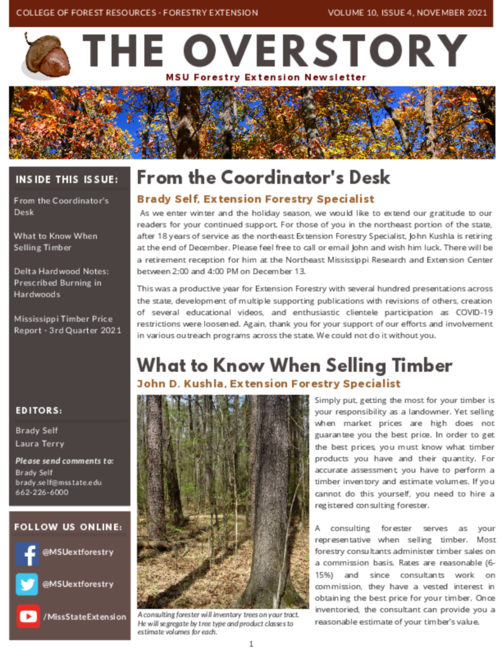The Overstory
Volume 10, Issue 4, November 2021
From the Coordinator's Desk
Brady Self, Extension Forestry Specialist
As we enter winter and the holiday season, we would like to extend our gratitude to our readers for your continued support. For those of you in the northeast portion of the state, after 18 years of service as the northeast Extension Forestry Specialist, John Kushla is retiring at the end of December. Please feel free to call or email John and wish him luck. There will be a retirement reception for him at the Northeast Mississippi Research and Extension Center between 2:00 and 4:00 PM on December 13.
This was a productive year for Extension Forestry with several hundred presentations across the state, development of multiple supporting publications with revisions of others, creation of several educational videos, and enthusiastic clientele participation as COVID-19 restrictions were loosened. Again, thank you for your support of our efforts and involvement in various outreach programs across the state. We could not do it without you.
What to Know When Selling Timber
John D. Kushla, Extension Forestry Specialist
Simply put, getting the most for your timber is your responsibility as a landowner. Yet selling when market prices are high does not guarantee you the best price. In order to get the best prices, you must know what timber products you have and their quantity. For accurate assessment, you have to perform a timber inventory and estimate volumes. If you cannot do this yourself, you need to hire a registered consulting forester.
A consulting forester serves as your representative when selling timber. Most forestry consultants administer timber sales on a commission basis. Rates are reasonable (6- 15%) and since consultants work on commission, they have a vested interest in obtaining the best price for your timber. Once inventoried, the consultant can provide you a reasonable estimate of your timber’s value.
After inventorying your timber, the consultant develops a sales prospectus to advertise your sale. You should let your consultant know about any specific conditions you want in the timber contract. In Mississippi, best management practices (BMPs) are voluntary. These are guidelines that cover practices for skid trails and roads, landings, logging debris, equipment maintenance, and streamside management zones. To enable enforcement, your timber contract should include a clause requiring use of Mississippi BMPs for forestry. Also, the contract will specify a period in which the buyer has to harvest your timber.
When selling timber for final harvest, a bid sale is the best approach for landowners to receive highest prices. Once your sale is announced, potential buyers are given an opportunity to offer bids. Buyers meet at a designated time and place to offer one bid. Usually, a hold-harmless clause is included in case no bid meets your satisfaction.
Remember, it is your responsibility to get the best price when selling timber. To do this, you must know what you have. If you don’t, hire a forest consultant to help you conduct your sale. If you have any questions, please contact your local county Extension office.
Delta Hardwood Notes: Prescribed Burning in Hardwoods
Brady Self, Extension Forestry Specialist
As far as forest management options go, prescribed fire is often one of the most controversial tools available to hardwood managers. The treatment has a positive longstanding reputation in pine management but is either treasured or loathed in hardwood silviculture dependent upon what species are present and the targeted end goal for the stand. These contrasting views of the practice have evolved from experiences of managers burning hardwood stands to achieve various fuel reduction and habitat manipulation goals while trying to keep from damaging overstory trees during the process.
Successfully burning hardwood stands without significant damage is possible if a few basic considerations are met. First, while it is possible to burn bottomland hardwood stands under very dry conditions, typically species in these systems are thinner barked compared to those in upland systems. Consequently, they are much more readily damaged when exposed to fire often resulting in irreparable damage to overstory trees. Upland hardwood species have evolved to possess much thicker bark on average and can withstand fire more readily than their bottomland counterparts. The drier nature of these stands also allows for a wider range of fuel moisture giving burn managers opportunity to utilize less intense fires. As long as cool-season burning (winter to early spring at green up) is implemented carefully, undue damage in these stands can be avoided. Just remember that the changing nature of weather and stand conditions makes it impossible to set an exact date range for burning in these systems.
If employed carefully, burning in upland hardwoods is a useful tool in habitat improvement efforts in wildlife management. The practice can also give forest managers a low-cost tool to help build hardwood regeneration levels in natural regeneration attempts. For more information on prescribed fire, please call your local county Extension office.
Mississippi Timber Price Report - 3rd Quarter 2021
Marc Measells, Senior Extension Associate
The Mississippi Timber Price Report provides a picture of timber market activity across the state showing regional and statewide stumpage prices for common forest products. This report should only be used as a guide to help individuals monitor timber market trends. The average price should not be applied as fair market value for a specific timber sale because many variables influence actual prices individual landowners receive. This report and previous historical timber prices are available by contacting your local county Extension office
3rd Quarter 2021 Stumpage Prices/Ton (Source: MSU Extension)
NOTE: Prices vary widely across the state; average prices presented here may not reflect your local market.
Price Trends:
Mississippi saw above normal rainfall during the 3rd quarter, leading to price increases for many areas. Landowners with land that could be harvested during wet weather benefited. Figures reflect 10-year statewide average price trends. Compared to 2nd quarter, statewide average prices changed (-2.8% to 27.9%) with pine poles and oak sawtimber prices declining. Prices varied for some product classes across regions. Prices for dimensional lumber peaked in May with steady declines through mid-August. The good news, mills are continuing with announced expansions and new construction. Some mills will begin production during 4Q 2021 and into next year. This added production capacity will benefit many landowners within the procurement radius of those mills.
Housing starts peaked in December 2020 and have fluctuated since. New housing permits declined because of record lumber prices. The unemployment rate has continued declining. As unemployment rates and the overall economy continue to improve, timber markets should recover. Most economic forecasters still expect the recovery to continue well into 2022. Prices during the 4th quarter should see slight increases due to wetter weather and as these new mill expansions and openings start accepting wood deliveries. Keep in mind, even though new mills and mill expansion will increase demand on our standing trees, Mississippi still has an overabundant supply of standing timber which will keep prices from increasing dramatically.
Authors
-
 Extension Professor
Extension Professor- Forestry
-
 Extension Instructor I
Extension Instructor I- Forestry
